University of California, Riverside
More Than Garden Variety
Take a tour of UCR’s world-renowned Givaudan Citrus Variety Collection
Long before it was a university, UCR has its roots as the Citrus Experiment Station, first established at the base of Riverside’s Mt. Rubidoux by the UC Board of Regents in 1907. Soon after, USDA researchers and experiment station staff initiated the Citrus Variety Collection in 1910. Now known as the Givaudan Citrus Variety Collection (GCVC), its purposes are threefold: to conserve and evaluate citrus and citrus relatives; to provide a resource of citrus genetic diversity for research; and to extend knowledge about citrus diversity.
Today, the collection houses approximately 4,500 trees of nearly 1,100 cultivars and species of citrus and related plants — several of which were developed at UCR as part of the citrus breeding program — representing one of the most extensive collections in the world. Here’s a look at just a few of the many unique varieties housed in the collection, and the important work being conducted by UCR researchers to develop and conserve citrus for future generations.
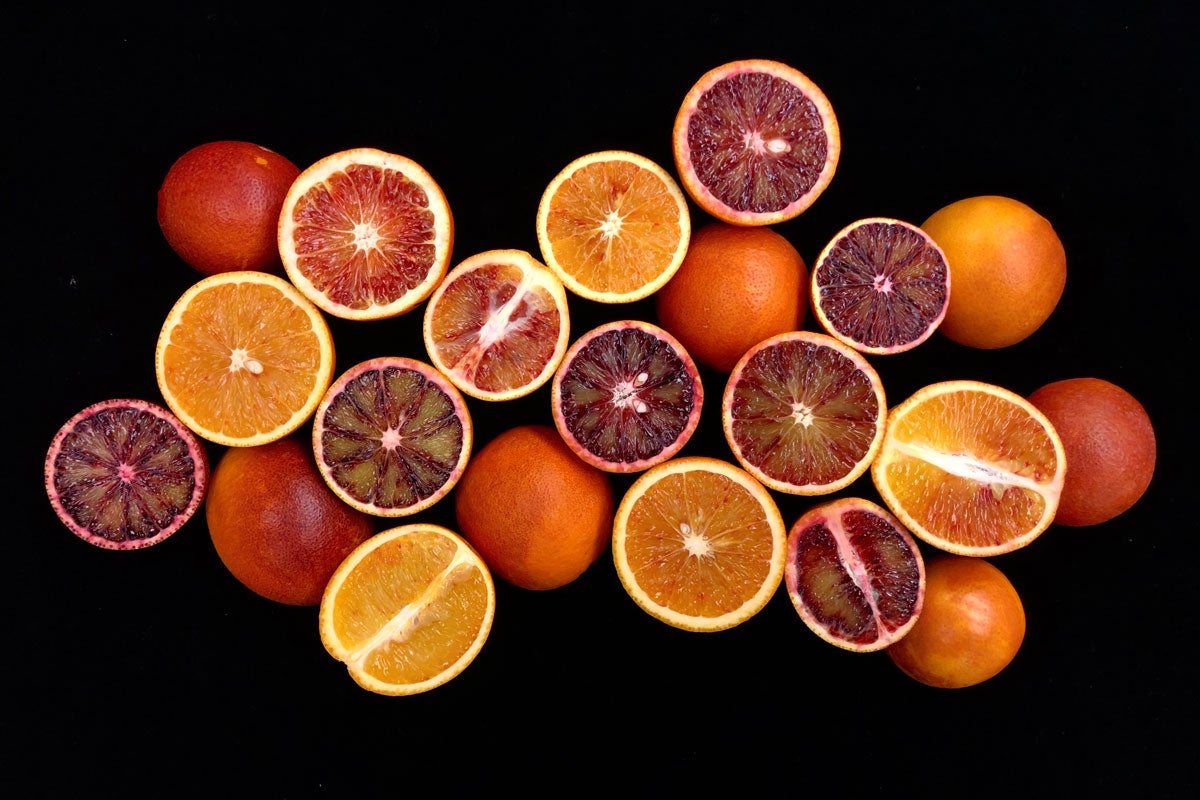
Blood Orange Varieties
The GCVC holds 22 varieties of blood oranges, many imported from locations throughout the world. The fruits’ red color is due to anthocyanin, a pigment found in the oranges stemming from a naturally occurring genetic mutation. The mutation is known to be temperature-dependent and will produce a deeper red color when a region has cold nights and warm days during fruit development and maturation. Blood oranges in the collection showcase a variety of internal and external anthocyanin pigmentation expression.
(Photo by Karene Trunnelle and Toni Siebert Wooldridge)
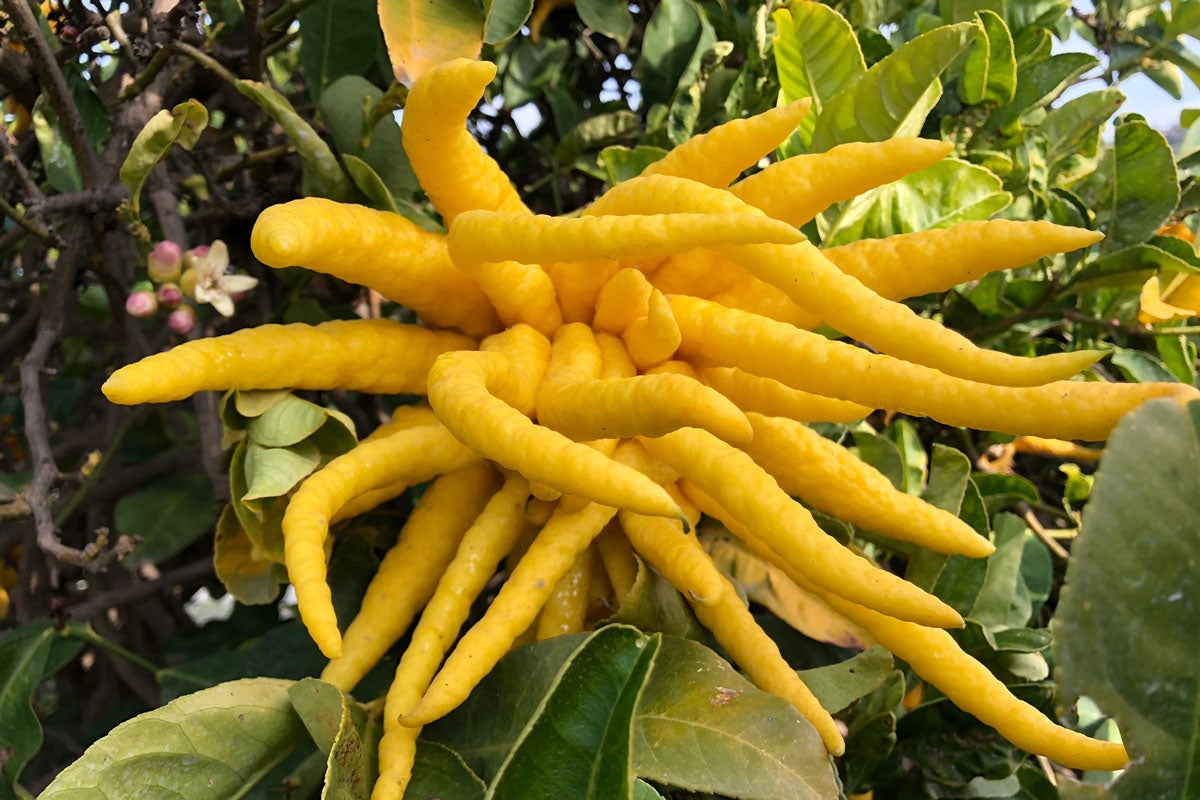
Buddha’s Hand Citron
One of the most unusual fruits in the collection is the Buddha’s Hand citron. Segmented into sections resembling fingers, the fruit is composed entirely of the spongy, white part of citrus fruits, called albedo, with no juicy pulp or seeds. Prized for its form and aroma, the fruit is also edible and used in desserts, savory dishes, and traditional medicine. It is believed that Buddhist monks brought the variety from India to ancient China where it was cultivated within the Yangtze Valley. While the GCVC has one variety of Buddha’s Hand, there are a dozen varieties or sub varieties of the species in Asia, varying in color, size, and shape. Buddha’s Hand is regarded as a symbol of happiness, wealth, and longevity across many cultures throughout the world.
(Photo by Karene Trunnelle)
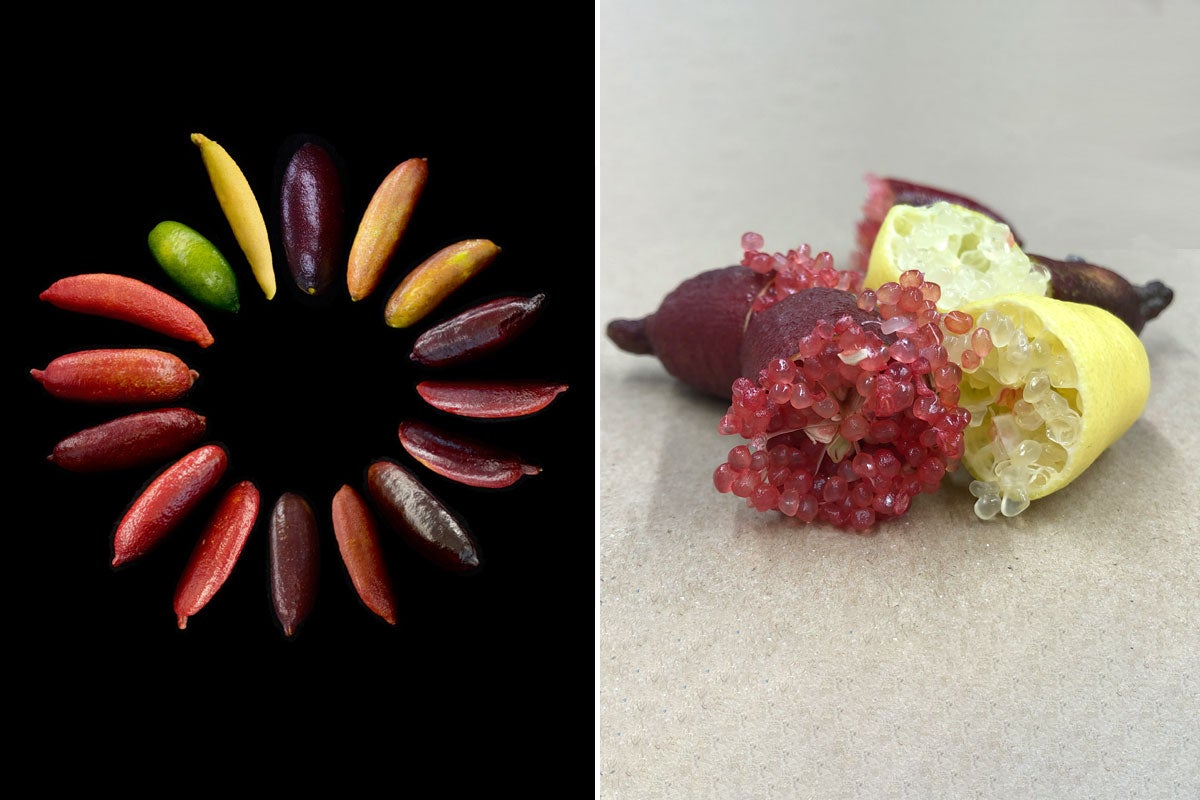
Australian Finger Limes
The GCVC also preserves relatives of citrus, specifically 28 genera within the Rutaceae family. This includes the Microcitrus australasica, or Australian finger lime. One of six species of citrus native to Australia, the small fruits are tart like lime, range in color, size, and shape, and contain juice vesicles sometimes referred to as “citrus caviar.” These fruits were part of a 6-year collaboration between the GCVC and USDA National Clonal Germplasm Repository for Citrus and Dates at UCR. Approximately 130 seedlings were evaluated over a 5-year term resulting in the selection of 18 of superior fruit quality characteristics. Shown on the left are 16 of the 18 selections that will be released to the citrus industry.
(Photos by Karene Trunnelle and Toni Siebert Wooldridge)

Navel Orange Mutations
Since the turn of the 20th century, the Washington navel orange has been one of the most important fruit varieties grown in the U.S. Introduced from Bahia, Brazil, in 1870, citrus growers in Riverside immediately recognized its commercial value due to its size, shape, color, and seedlessness. Early growers also noticed naturally occurring bud and limb variations in many navel orange cultivars, and the odd traits of the fruits caught the eye of early citrus scientists. While some types were deemed unacceptable for commercial orchards, others were viewed as potentially valuable. Many navel orange mutations are represented in the GCVC, presenting a variety of traits such as rind corrugation, as shown in the corrugated Thomson (bottom left). Some selections were made for ornamental purposes, like the variegated navel above (top left). Other selections include the lycopene (pink) pigmented navel from Venezuela called “Cara Cara” (bottom right) and an anthocyanin (red) pigmented navel known as “Shahani Red” (top right) found in the backyard of hobbyist Frank Shahani of Upland, California.
(Photos by Karene Trunnelle and Toni Siebert Wooldridge)
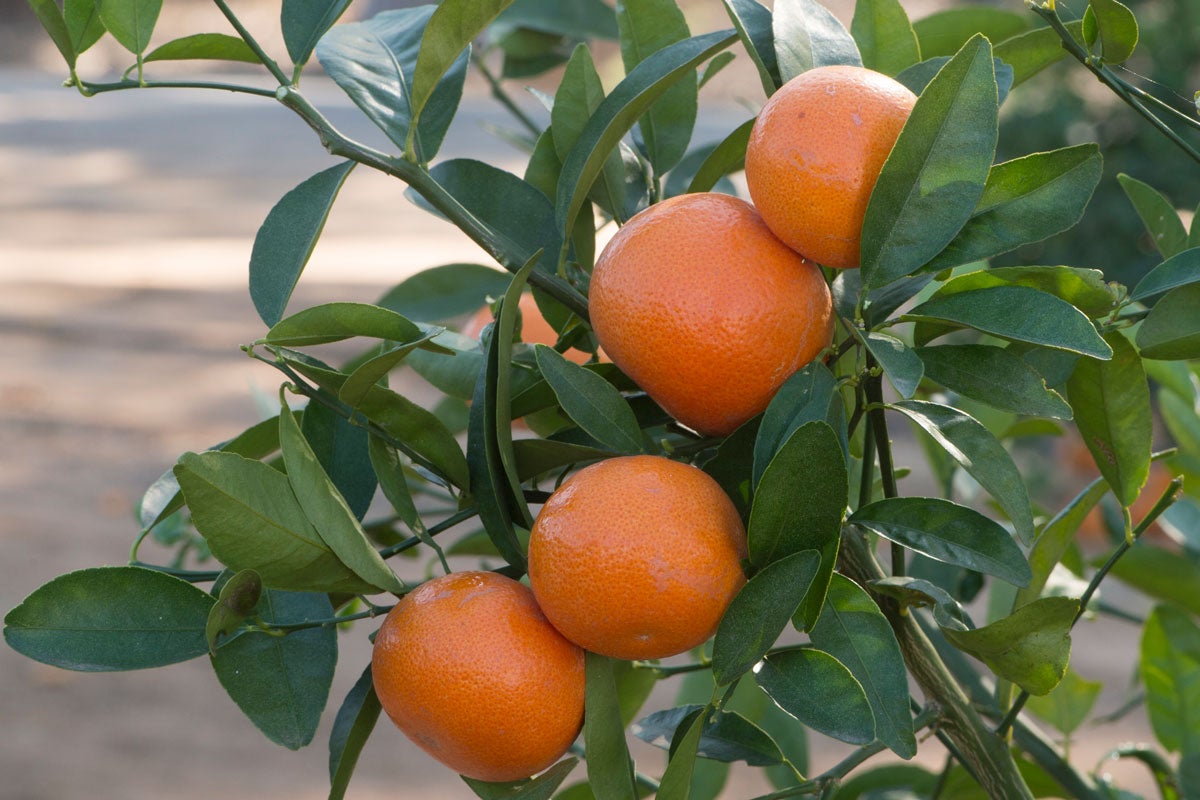
Tango Mandarin
The easy-peel “Tango” mandarin was developed by UCR geneticists Mikeal Roose and Tim Williams and released commercially in 2006. A seedless version of the popular W. Murcott mandarin, “Tango” is a widely popular variety now sold in over 50 countries, sometimes marketed under the “Cuties” brand. During the 2020-2021 season, the variety represented 29% of the total acreage planted in California. “Tango” is among the highest-earning inventions within the UC system, generating more than $50 million in royalty revenue for UCR since its release.
(Photo by David Karp and Toni Siebert Wooldridge)

King Tangor
One of the GCVC’s oldest accessions, the King tangor variety originated as a seedling from fruits received by H. S. Magee of Riverside in 1880, courtesy of the U.S. minister to Japan, John A. Bingham, who arranged to have them sent from Saigon, Vietnam. With its high heat requirement, the King is among the latest ripening of mandarin varieties. Consequently, its range of commercial adaptation in California was restricted but had some importance in hot interior districts of the Inland Empire. Pictured here is a historical fruit label for King tangor from Highland, California, circa 1906.
(Photo by Karene Trunnelle and Toni Siebert Wooldridge, fruit label scan provided from the collection of David Karp)

Oroblanco Grapefruit Hybrid
Oroblanco is a well-known seedless white grapefruit and pummelo hybrid produced by Robert Soost and James Cameron, former co-chairs of the UCR Breeding Program. Initially crossed in 1958, this variety wasn’t officially patented and released until 1980. Oroblanco, meaning “white gold” in Spanish, has a thick, smooth, greenish-yellow rind at maturity, and its pale yellow flesh has a mild, sweet flavor lacking the bitterness and acidity of a typical grapefruit.
(Photo by David Karp and Toni Siebert Wooldridge)

TDE Mandarin Varieties
These sibling mandarin varieties are complex hybrids of the Temple tangor, Dancy mandarin, and Encore mandarin with a shared parentage. The original crosses were made by Soost and Cameron in 1973, and selections from those crosses, dubbed TDE1, TDE2, TDE3, and TDE4, were made in the late 1980s. While they are all low-seeded or seedless with deep orange, easy-to-peel rinds and a rich, sweet flavor, the fruits all differ in maturity times. After years of trials, data collection, and observation, three of the four were patented and released by UCR in 2002, trademarked as Shasta Gold (TDE2), Tahoe Gold (TED3), and Yosemite Gold (TDE4). TDE1 was never released, however the GCVC retains all four sibling selections.
(Photo by Karene Trunnelle and Toni Siebert Wooldridge)

Variegated Pink-Fleshed Eureka Lemon
Variegated pink-fleshed Eureka lemon, also marketed as “Pink Lemonade,” is a bud mutation of the conventional Eureka lemon. The selection was made from a home garden in Burbank in 1931. The leaves are variegated green and white, and the rind of the fruit is striped green and cream. When fully ripe, the stripes fade, and the rind turns yellow with distinct pink oil glands. The internal flesh is light pink at full maturity, low-seeded, and very acidic. This ornamental variety can go for twice the price of a standard lemon in grocery stores and farmers markets.
(Photo by David Karp and Ottillia Bier)
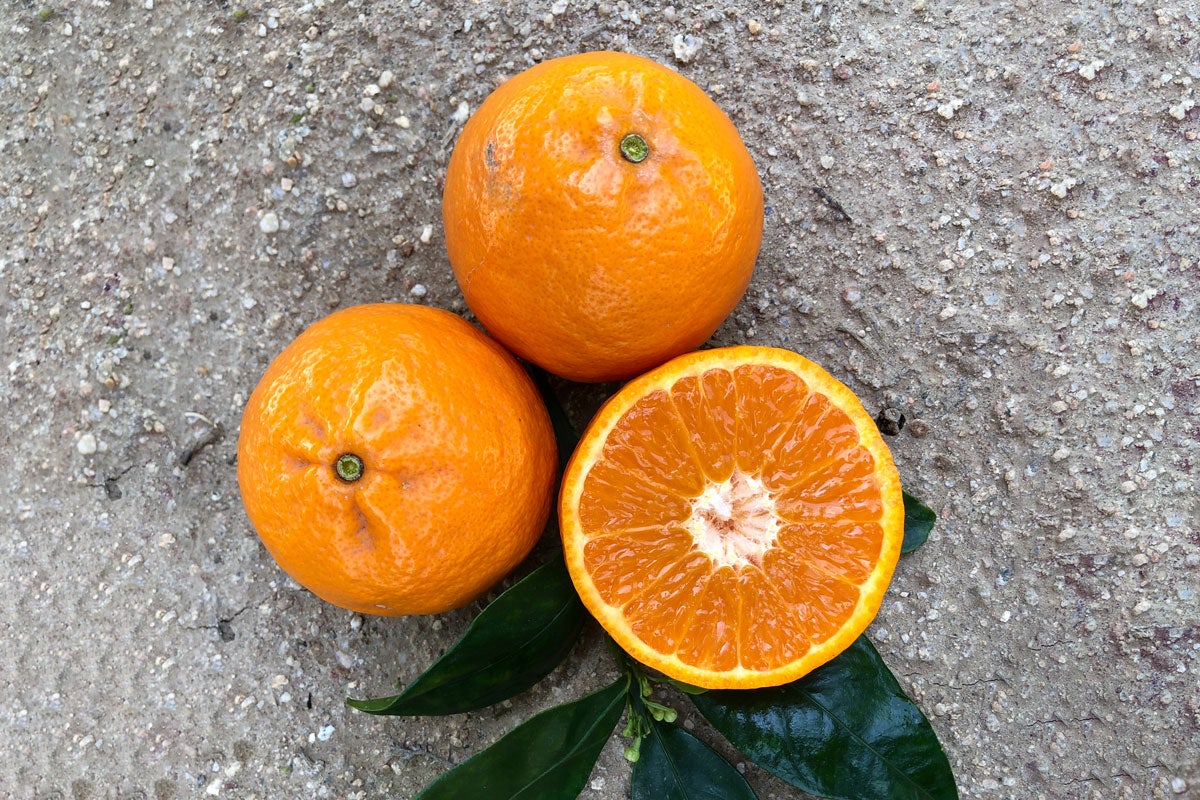
Gold Nugget Mandarin
The Gold Nugget mandarin was developed at UCR in the 1950s and eventually released to the industry in August 1999 by Roose, who serves as director of the citrus breeding program. This late-maturing variety has an easy-to-peel bumpy orange rind, for which it gets its “Gold Nugget” moniker, and its sweet, mildly acidic flavor is considered to be one of the best-tasting of all citrus varieties. A hybrid of the seedy Wilking mandarin and Kincy mandarin, the Gold Nugget variety is surprisingly seedless. When asked how this was possible, Roose once stated, “Sometimes we have children we cannot explain.”
(Photo by Karene Trunnelle and Toni Siebert Wooldridge)
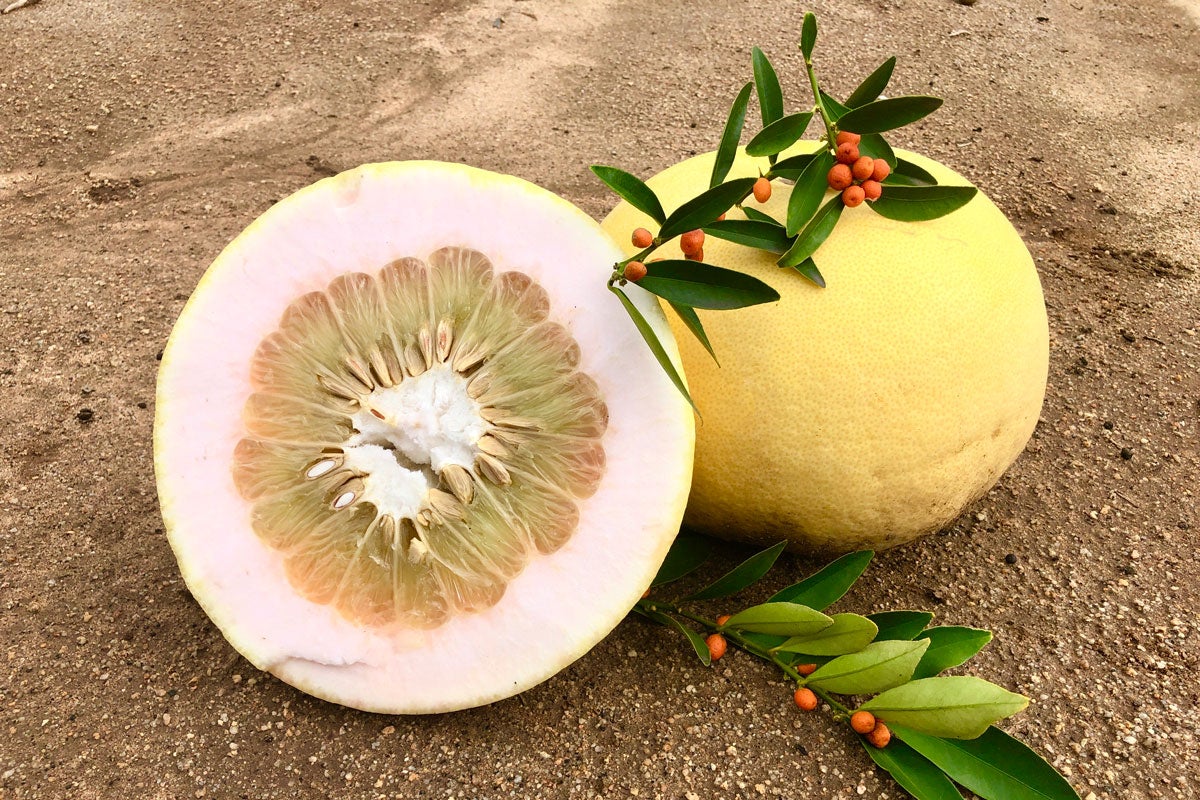
Biggest and Smallest Fruits
Any time you take a tour of the GCVC, you’ll hear, “We have things as big as your head and as small as a pebble.” Here is the proof. The largest accession of true citrus in the collection is the Moanalua pummelo, received from Hawaii in 1914. The smallest is the Hong Kong kumquat, originating from Malaysia. Its fruits rarely exceed one-half inch in diameter.
(Photo by Karene Trunnelle and Toni Siebert Wooldridge)

Australian Desert Lime
The unusual Eremocitrus glauca, commonly referred to as Australian desert lime, is a close relative of citrus that is indigenous to the semi-arid regions of Australia. Early plant exploring expeditions in the mid-1800s revealed that Eremocitrus can withstand severe cold, burning heat, and extreme soil and air dryness. Flowering in spring, the trees produce marble-sized fruits that mature within a few months and then drop off within weeks. The GCVC received a Eremocitrus budwood from Joe Furr, a researcher at the former USDA Date and Citrus Station in Indio, in 1962. The Eremocitrus glauca is of particular interest to current research at UCR for its known resistance to Huanglongbing, a fatal disease devastating the Florida citrus industry that also poses a major threat to California.
(Photo by Karene Trunnelle)
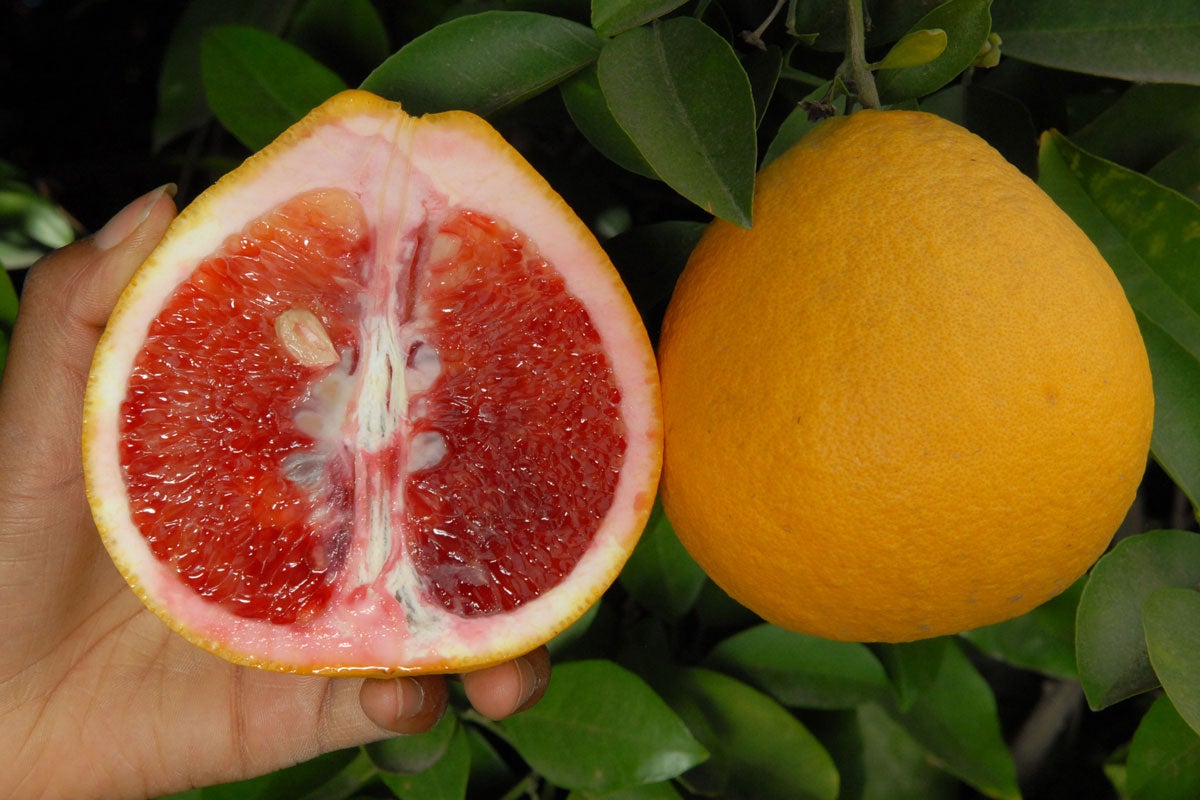
“Valentine” Pummelo Hybrid
“Valentine” is a hybrid developed at UCR in the 1950s, the result of a cross between a Siamese Sweet pummelo and a Ruby blood orange-Dancy mandarin hybrid. Ottillia “Toots” Bier, a former GCVC staff research associate, nicknamed the hybrid “Valentine” not only because the fruit matures in mid-February near Valentine’s Day, but it also resembles a vibrant red heart when cut lengthwise and turned upside down. A large, juicy fruit with low-acidity and sweet, floral flavors, “Valentine” is a favorite among visitors of the GCVC.
(Photo by Toni Siebert Wooldridge)
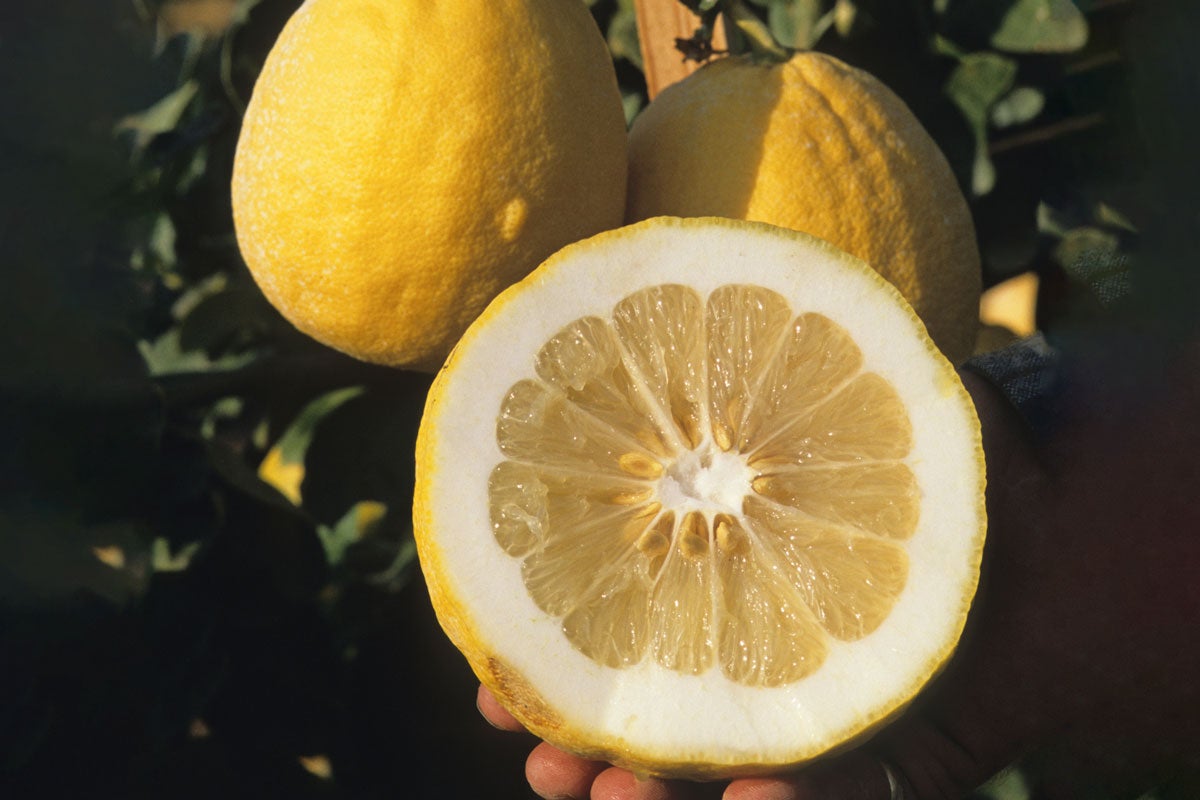
Ponderosa Lemon
The largest “lemon” variety in the collection, Ponderosa is actually a citron-lemon hybrid that originated around 1887 as a chance seedling grown by George Bowman of Hagerstown, Maryland. It was introduced into the nursery trade in 1900 where it was sometimes called “Wonder lemon” or “American Wonder lemon.” The large fruits weigh more than one pound and are juicy, sour, and seedy. Although the fruit can be used as a lemon substitute, Ponderosa is of importance primarily as an oddity and ornamental.
(Photo by David Karp)














Karene Trunnelle and Toni Siebert Wooldridge, museum scientists in the Botany and Plant Sciences Department, provided the photos and collaborated on the content of this article.
Learn more about the Givaudan Citrus Variety Collection at citrusvariety.ucr.edu and on Instagram @citrusvarietycollection, and get a bird’s-eye view of the collection in this drone tour.